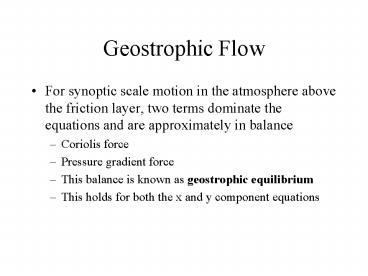Geostrophic Flow PowerPoint PPT Presentation
1 / 11
Title: Geostrophic Flow
1
Geostrophic Flow
- For synoptic scale motion in the atmosphere above
the friction layer, two terms dominate the
equations and are approximately in balance - Coriolis force
- Pressure gradient force
- This balance is known as geostrophic equilibrium
- This holds for both the x and y component
equations
2
Geostrophic Flow
- We can write the geostrophic equations as
- The subscripts g on the velocity components are
to emphasize that the winds associated with the
solution to these equations is the geostrophic
wind - Note that the meridional geostrophic velocity
depends on the zonal pressure gradient, and that
the zonal geostrophic velocity depends on the
meridional pressure gradient
3
Geostrophic Flow
- We can also write the geostrophic equations with
respect to the height of a constant pressure
surface - f is the Coriolis parameter f 2?sin?
- g is the Earths gravity
4
Geostrophic Flow
- We can combine the two scalar equations into a
vector one - (6.2)
- The geostrophic equation is diagnostic
- This means that if we know the height field, we
can determine the present wind field - But we can NOT use the equation to forecast
future values of the wind - The wind speed is proportional to the magnitude
of the pressure gradient, and it direction is
parallel to the isobars - Low pressure is to the left in the Northern
Hemisphere - This result is also known as Buys Ballot Law
5
Geostrophic Flow Implications
- 1) Thermodynamics controls the dynamics
- The geostrophic wind is determined by the
pressure field in the atmosphere - But the pressure field in the atmosphere is
determined by the mass distribution - And the mass distribution depends on the density
field - And the density field is set by the temperature
field through the ideal gas law
6
Geopotential
- Geopotential - defined such that the change in
the geopotential, d?, over the vertical distance,
dz, is given by the amount of work done (or
potential energy gained) in raising a mass M
through a vertical distance dz against the force
of gravity - Note that units are energy per unit mass (J kg-1
or m2 s-1) - The approximation comes because of small
variations of g with height, which we will ignore
7
Geopotential
- We can also write the geostrophic wind equations
in terms of the geopotential
8
Geostrophic Thermal Wind
- The geostrophic thermal wind is not actually a
wind - For example, it units are not m/s
- Actually it is the vertical shear of the
geostrophic wind - NOT the vertical shear of the actual wind
- We can thus write a geostrophic thermal wind
equation
9
Geostrophic Thermal Wind
- The thermal wind vector lies in the plane of the
constant pressure surface - It is also perpendicular to the temperature
gradient - Therefore, the thermal wind vector runs parallel
to the isotherms - Thus, in the free atmosphere the tendency for the
wind to run parallel to isotherms (or thickness
contours) is consistent with the geostrophic idea - The thermal wind tends to rotate the wind vector
into alignment with the isotherms
10
Geostrophic Thermal Wind
11
Geostrophic Thermal Wind
- Notes
- Only in regions where the wind vector cuts across
the isotherms do we have temperature advection - The thermal wind vector points with colder air on
its left - Above the friction layer, merely by observing the
turning of the wind with height on a sounding, we
can infer whether warm or cold advection is
occurring locally - On soundings with little change in wind direction
with height, no temperature advection is occurring

